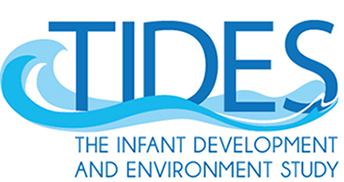The Infant Development and Environment Study (TIDES)
About TIDES
 The Infant Development and Environment Study (TIDES) is a multi-center pregnancy cohort that focuses on the impact of environmental exposures during pregnancy on child health and development.
The Infant Development and Environment Study (TIDES) is a multi-center pregnancy cohort that focuses on the impact of environmental exposures during pregnancy on child health and development.
The study takes place at four centers:
- University of California, San Francisco
- University of Minnesota
- University of Rochester Medical Center
- Seattle Children’s Hospital/University of Washington
Seattle Children’s Research Institute serves as the TIDES Data Coordinating Center (formerly the Icahn School of Medicine at Mount Sinai).
TIDES I and II
From 2009 to 2014, TIDES recruited pregnant women to investigate the association between phthalate exposures in pregnancy and reproductive outcomes in children (TIDES I). During this phase, participants completed study visits during each trimester, a birth exam and a 12-month follow up visit (males only). The second phase (TIDES II) examined effects of phthalates and stress on early life growth and neurodevelopment and included visits at age 4 and age 6. Read more details about the TIDES project.
TIDES ECHO
 TIDES is now part of a nationwide research program called the Environmental Influences on Child Health Outcomes Program (ECHO), whose mission is to improve health for generations to come. Supported by the National Institutes of Health, the ECHO program includes over 70 cohorts like TIDES. ECHO expects to include nearly 50,000 children and families from 44 states to address five important child health issues: asthma, neurodevelopment, obesity, airway health and birth outcomes. Visit the ECHO website for more information.
TIDES is now part of a nationwide research program called the Environmental Influences on Child Health Outcomes Program (ECHO), whose mission is to improve health for generations to come. Supported by the National Institutes of Health, the ECHO program includes over 70 cohorts like TIDES. ECHO expects to include nearly 50,000 children and families from 44 states to address five important child health issues: asthma, neurodevelopment, obesity, airway health and birth outcomes. Visit the ECHO website for more information.
What Have We Learned
Maternal urinary levels of glyphosate during pregnancy and anogenital distance in newborns in a US multicenter pregnancy cohort. Lesseur C, Pirrotte P, Pathak KV, Manservisi F, Mandrioli D, Belpoggi F, Panzacchi S, Li Q, Barrett ES, Nguyen RHN, Sathyanarayana S, Swan SH, Chen J. Environ Pollut. 2021 Jul 1;280:117002. Epub 2021 Mar 22.
Glyphosate is a weed-killing chemical widely used in agriculture in the United States and worldwide. In this study, we measured glyphosate levels in urine samples from 94 pregnant TIDES moms and then examined whether these levels were related to newborn anogenital distance (AGD, distance between the anus and the genitals). AGD is important because it is a marker of the fetus’ exposure to testosterone in the womb and influences the development of the reproductive system. Glyphosate was detected in 95% of the urine samples, and newborn daughters of moms who had higher levels of glyphosate during pregnancy had a longer AGD at their birth exam, reflecting higher exposures to testosterone in the womb compared to those with a shorter anogenital distance. The findings are discussed further in this article.
Associations between urinary biomarkers of oxidative stress in the third trimester of pregnancy and behavioral outcomes in the child at 4 years of age. Rommel AS, Milne GL, Barrett ES, Bush NR, Nguyen R, Sathyanarayana S, Swan SH, Ferguson KK. Brain Behav Immun. 2020 Nov;90:272-278. Epub 2020 Sep 6.
Oxidative stress refers to an imbalance between molecules that can promote well-being and those that can harm health (technically, more reactive oxygen species than healthy antioxidants). Oxidative stress during pregnancy has been linked to preterm birth. We studied the relationship between oxidative stress and child development within TIDES. We focused on behavioral problems in children at age 4 years, including social skills, hyperactivity, aggression, anxiety, depression, and attention problems. We found that in women who had at least some college education, higher levels of oxidative stress during pregnancy were linked to increased behavior problems in the child at age 4 years. In less educated women, oxidative stress during pregnancy did not appear to be related to child behavior at age 4. It may be that structural (e.g., poverty, pollution) and individual-level (e.g., health behaviors, genetics) stressors are more important for behavioral outcomes in families with less-educated moms.
Current Visits
We are now conducting the Age 9–10 study visit at the Seattle site. Visits take place at the Pediatric Clinical Research Center at Seattle Children’s Hospital. Read more information about study visits.
